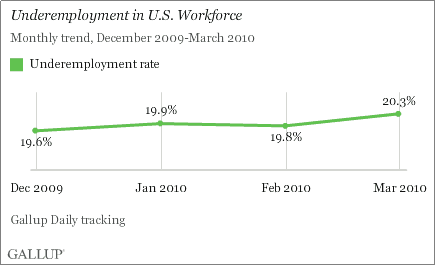Underemployment In The U.S. Rises to 20.3% in March
Economics / US Economy Apr 04, 2010 - 06:57 AM GMTBy: Dian_L_Chu
 Reports from the Labor Department today showed companies in the U.S. created more jobs in March than at any time in the past three years, showing the recovery is broadening and becoming more entrenched.
Reports from the Labor Department today showed companies in the U.S. created more jobs in March than at any time in the past three years, showing the recovery is broadening and becoming more entrenched.
Payrolls rose by 162,000 workers, the most gain since March 2007, though the increase included 48,000 temporary Census workers. Unemployment remains at 9.7% for a third month.
Record Long-term Unemployed
Nevertheless, behind the rosy headlines, data from the Bureau of Labor Statistics also give a grim side of the employment picture.
The number of long-term unemployed (longer than 27 weeks) in March rose to more than 6.5 million. The percentage of people unemployed for 27 weeks or more also rose to a record 44.1% of all jobless.
The Labor Dept. figures also showed average earnings per hour dropped last month and the number of people working part-time because they couldn’t find full-time work increased.
A Rise in The Underemployed
The underemployment rate -- which includes the part-timers and people who want work but have given up looking - - increased to 16.9% from 16.8%, based on government data, seasonally adjusted.
However, the latest Gallup Daily tracking finds that 20.3% of the U.S. workforce was underemployed in March-- a slight uptick from the relatively flat January and February numbers. Gallup employment data are not seasonally adjusted. (See chart)

Gallup concludes its findings as follows:
As unemployed Americans find part-time, temporary, and seasonal work, the official unemployment rate could decline. However, this does not necessarily mean more Americans are working at their desired capacity. It will continue to be important to track underemployment -- to shed light on the true state of the U.S. workforce."
Meaningful Job Creation = More Budget Deficits
So what can be done?
Congress has extended unemployment benefits for longer periods to help workers cope. A jobs bill Congress recently passed gives employers a tax credit for hiring workers unemployed for two months or more.
Such credits don't actually create jobs. A new infrastructure program, for example, would certainly help the 24.9% unemployed Americans in the construction sector.
Unfortunately, any meaningful job creation programs would require more deficit spending on a new stimulus bill, which is politically impossible in an election year.
So, we are pretty much in the predicament as described by Secretary Geithner in a recent inteview at NBC’s "Today" show,
"[The unemployment rate] is still terribly high and is going to stay unacceptably high for a very long time,"
Overly Optimistic Markets?
Meanwhile, markets have turned increasingly bullish on economic growth sending the S&P 500 Index and the Dow Jones Industrial Average to their highest closes in 18 months.
Although the course of the economy and markets is generally heading towards the positive direction, the grim labor market outlook could come into play sooner rather than later, among some other downside risk factors. From that perspective, stocks may have been fully priced or even gotten ahead of themselves.
Disclosure: No Positions
Dian L. Chu, M.B.A., C.P.M. and Chartered Economist, is a market analyst and financial writer regularly contributing to Seeking Alpha, Zero Hedge, and other major investment websites. Ms. Chu has been syndicated to Reuters, USA Today, NPR, and BusinessWeek. She blogs at Economic Forecasts & Opinions.
© 2010 Copyright Dian L. Chu - All Rights Reserved Disclaimer: The above is a matter of opinion provided for general information purposes only and is not intended as investment advice. Information and analysis above are derived from sources and utilising methods believed to be reliable, but we cannot accept responsibility for any losses you may incur as a result of this analysis. Individuals should consult with their personal financial advisors.
© 2005-2022 http://www.MarketOracle.co.uk - The Market Oracle is a FREE Daily Financial Markets Analysis & Forecasting online publication.



